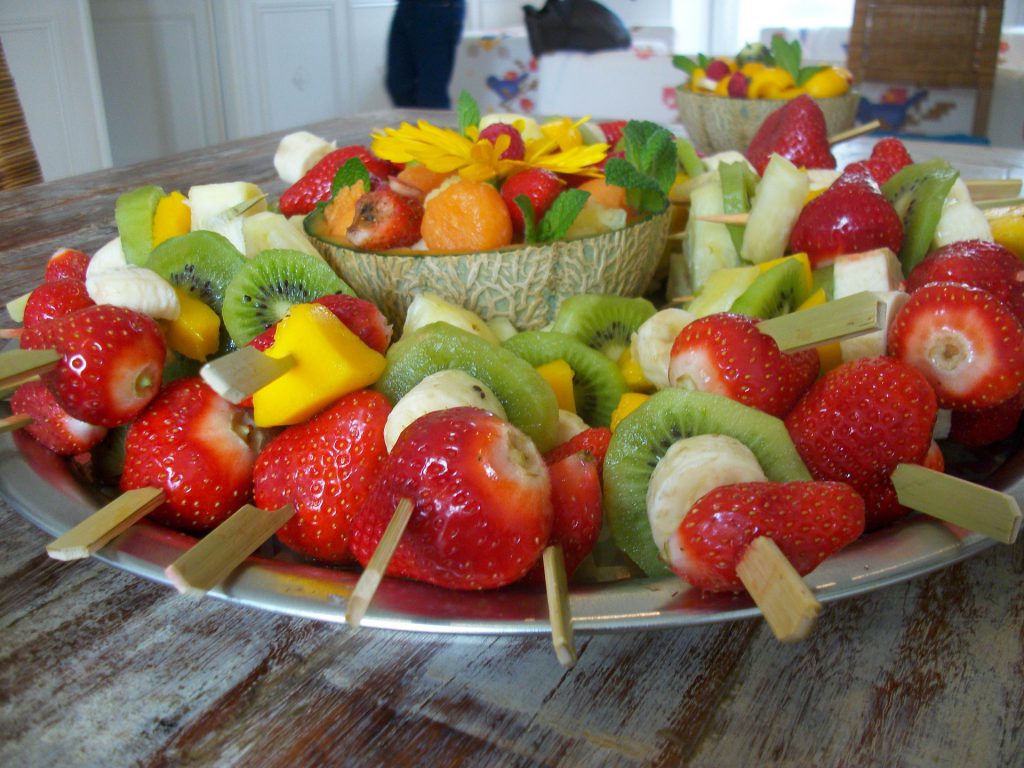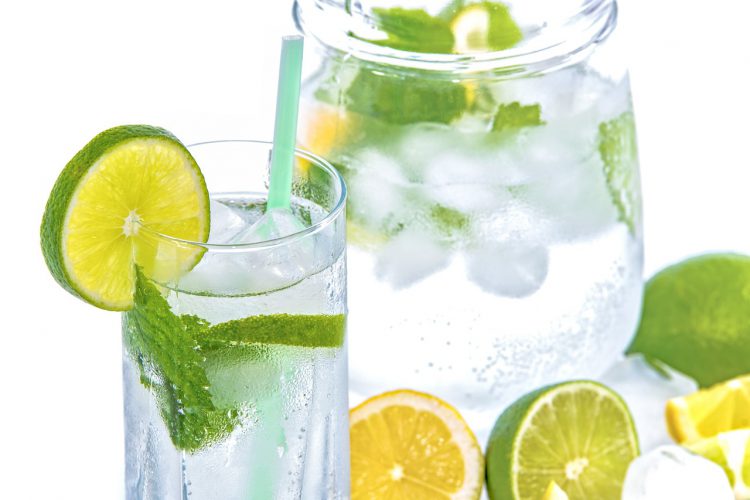Rainbow Kabobs

Ingredients
(Choose one item from each color category)
- Red
- 1 red bell pepper, washed, cored, and sliced
- 1 pint of strawberries, washed and sliced
- 1 small container of cherry tomatoes
- Orange
- 1 orange, washed, peeled, and sectioned
- 1 cantaloupe, washed and cut into square pieces
- Yellow
- 1 can pineapple chunks
- 1 banana, washed, peeled, and sliced
- Green
- 1 large bunch of green grapes, washed
- 1 cucumber, washed, peeled, and sliced in THICK slices
- Blue
- 1 pint of blueberries, washed
- Purple
- 1 bunch of purple grapes, washed
Directions
- With the help of an adult, prepare various ingredients listed for your kabob.
- To make a kabob, slide the fruit or vegetable onto a coffee stirrer or skewer.
Make a rainbow and enjoy!
Healthy eating on a budget!
Eating healthy on a budget can be really hard, especially if you’re paying for rent, gas, and other necessities. However, it can be done. The first step to successfully budgeting a healthy meal is to just create a game plan for your groceries. Research and look up tips for healthy, low-cost meals and master the skill of finding the best deals on items.

Shopping smart is the key to eating healthy on a budget. Realizing that the “unit price” is the better option for you can be beneficial in the long run. Reading each food label can also help make decisions easier when being mindful of healthiness. Each aisle of the grocery store has deals and discounts. Finding those will also benefit anyone on a budget. Preparing healthy meals can be easier by using kitchen timesavers. This makes it easier because you can make meals faster and more efficiently. Looking up new recipes to try can also help make things less complicated. Plus, this can bring a family together by introducing new things to meals.
There are plenty of budget-friendly recipes to choose, from a slow-cooked beef stew to summer chicken spring rolls; there are a variety of healthy recipes that factor in a budget. There are other options such as a grilled salmon, avocado salad and pesto chicken kabobs.
There are even tofu stir-fry options for those who are vegetarians. Making menus for every 2-weeks is also a budget-conscious habit that can save money and benefit health-wise. Keeping grocery and pantry staples lists are also great ideas in following a budget. Referring to the ChooseMyPlate model can also be informative on which food groups are needed in each meal. Utilizing your resources such as SNAP-ED and FNS can also help save money and accomplish healthy meal preparation.
Enjoy!
Taylor
Taylor is a student intern working with EFNEP at N.C. Cooperative Extension, Pitt County Center.
RESOURCE:
http://www.choosemyplate.gov/budget
http://www.diabetes.org/
Stress And Diet!

Think of all the things you do in a day. Perhaps feeling tired, irritable, or nauseous can be stress related. Too much stress without some relief can cause some serious health issues for you now and later in life. Heart disease and high blood pressure can be a result of being stressed-out. In you already have been diagnosed with diabetes, stress can worsen it. Those headaches that you may often get, can be related to stressful situations. How about that depression and/or anxiety you sometimes or often times feel? Don’t be surprised that chronic stress is also related to more frequent episodes of depression and anxiety.
I mentioned nausea earlier. Stress can make ulcers worse, cause heartburn, and even irritable bowel syndrome. Other culprits of too much stress in your life worsen asthma and Alzheimer’s, interrupt sleep, accelerate aging and even cause premature death.
So, now that you have realized that you have some of these symptoms, what do you do about it? Here are some ways you can fight back. Try breathing deeply, as just a few minutes can calm you. You don’t need any special equipment or location for this. You can do this while at work, while driving, cooking, or anytime you start to feel stress taking over.
Focus on the present. Don’t get too anxious about what you are going to next or feel guilty about something you may have forgotten to do. Take some “me” time and perhaps a walk, a stretch, or healthy snack break will bring your focus away from stressful things occurring.
I have found that when I am in traffic, I try use the time as an opportunity to catch up on the news, listen to some soothing music, or listen to an audio book. It takes my mind off of the traffic and really does lessen the stress.
Once you begin making some of these changes in your life, look ahead to some bigger changes that can become a new way of life for you. Start a regular exercise routine, as studies show that this can elevate your moods and give you more energy. Learn some techniques such as yoga or meditation which will relax you. Not only will you will your mood improve, but the long-term health benefits can be quite significant.
Enjoy!
Judy
Source: Harvard Health
Whats In Your Pantry?
Do you often feel there’s nothing in the pantry you can use to make a nutritious meal for your family? You might be surprised how easy it is to make a simple but healthy meal from just a few pantry items. Watch our latest video below
Enjoy!
Emily
The cheapest way to improve your health, drink water!

Lucky for us, in America water is free just about anywhere you go. Drinking water instead of sugar-sweetened beverages will not only help your wallet but could help to improve your health.
Although there are currently no set requirements for water consumption, the Food and Nutrition Board recommends that the average women consume 91 ounces daily (about 11 cups) and men consume 125 ounces daily (about 15 cups). (Certain groups may require higher intake levels, check with your doctor for more information).
This may seem unattainable to some but don’t worry, typically 20% of this amount is consumed within the foods you eat. With this in mind, women should aim to drink 8 cups of water-based beverages daily and men, 12 cups. If this still seems like a daunting task, below are some tips to include healthy drinks into your daily routine.
- Reusable water bottles can be a good way to encourage water consumption.
Tip: Look for a 16-ounce water bottle and every refill counts as 2 cups! - Infuse your water with your favorite fruits and herbs. See the recipe below to get you started.
Tip: Freeze fruits when they are in season, and usually a great deal. Once you need them they can serve to flavor your water and help keep it cold! - Soda-lover? Try switching to seltzer water or club soda. Look in your grocery store for calorie-free, carbonated drinks, available in a variety of flavors.
Tip: Most restaurants have club soda available on draft, just ask! - Attention caffeine-lovers: coffee and tea count towards your daily intake as well! Take it easy on the cream and sugar and these drinks can be a healthy way to reach your recommendations.
Tip: As a Northern originally, I am allowed to say that tea does not always have to be sweet…sorry! Try different flavors and make it hot or iced. My new favorite is honey vanilla chamomile!
Strawberry Mint Water:
-1/2 Cup frozen strawberries
-1/4 Cup fresh mint
-8 ounces water
-Combine all ingredients in a cup or water bottle.
Enjoy!!
Megan
Megan is the Adult EFNEP Program Assistant in Orange County Cooperative Extension.
Source: https://www.choosemyplate.gov/ten-tips-make-better-beverage-choices